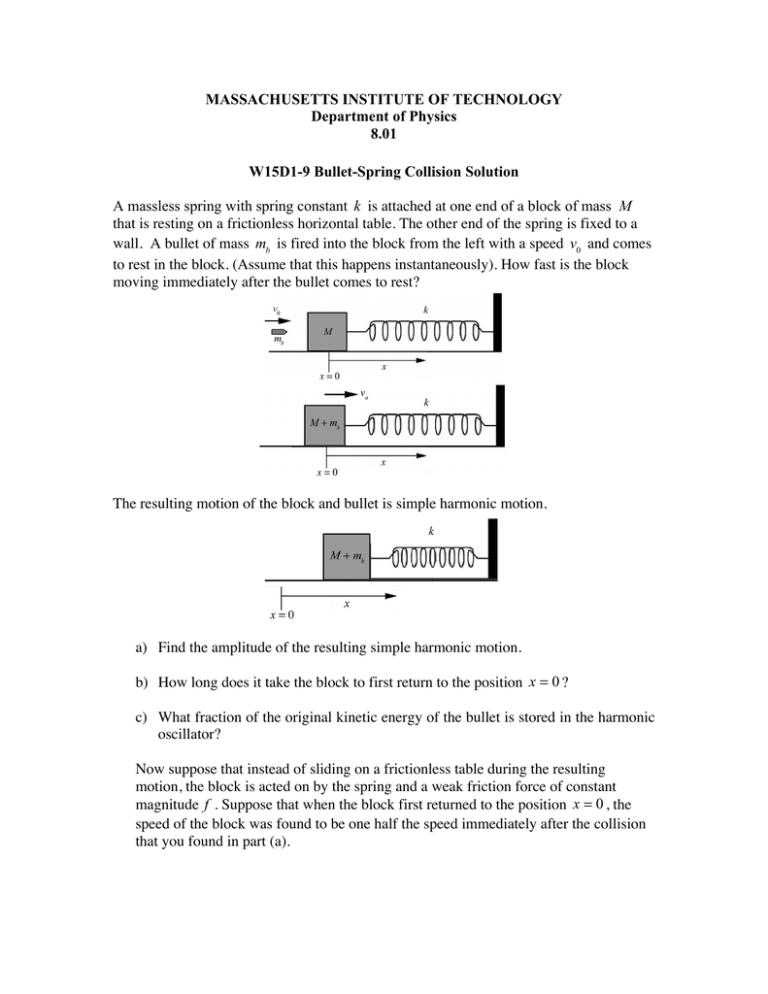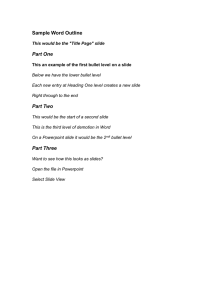MASSACHUSETTS INSTITUTE OF TECHNOLOGY Department of
advertisement

MASSACHUSETTS INSTITUTE OF TECHNOLOGY Department of Physics 8.01 W15D1-9 Bullet-Spring Collision Solution A massless spring with spring constant k is attached at one end of a block of mass M that is resting on a frictionless horizontal table. The other end of the spring is fixed to a wall. A bullet of mass mb is fired into the block from the left with a speed v0 and comes to rest in the block. (Assume that this happens instantaneously). How fast is the block moving immediately after the bullet comes to rest? The resulting motion of the block and bullet is simple harmonic motion. a) Find the amplitude of the resulting simple harmonic motion. b) How long does it take the block to first return to the position x = 0 ? c) What fraction of the original kinetic energy of the bullet is stored in the harmonic oscillator? Now suppose that instead of sliding on a frictionless table during the resulting motion, the block is acted on by the spring and a weak friction force of constant magnitude f . Suppose that when the block first returned to the position x = 0 , the speed of the block was found to be one half the speed immediately after the collision that you found in part (a). d) How far did the block travel? (Your answer may include the symbol va , the speed of the block immediately after the bullet comes to rest, whether or not you have answered part (a) correctly.) Solution: The collision is completely inelastic so mbv0 = (mb + M )va (1) Thus the speed immediately after the collision is va = mb v (mb + M ) 0 (2) The energy of the spring-object system is constant since there are no external work done on the system (no fricition), therefore 1 1 2 (mb + M )va 2 = kxmax 2 2 (3) where the maximum displacement xmax = (mb + M ) va = k 1 mv k(mb + M ) b 0 (4) is the amplitude of the simple harmonic motion. Alternatively, the position of the system is given by the solution to the simple harmonic equation: x(t) = Acos ω t + Bsin ω t where the angular frequency is given by (5) ω= k mb + M (6) The x-component of the velocity is given by vx (t) = −ω Asin ω t + ω B cos ω t At t = 0 , x(t = 0) = A = 0 , and vx (t = 0) = ω B = B= 1 mb v0 = ω (mb + M ) (7) mb v0 , so (mb + M ) mb + M mb v0 = k (mb + M ) 1 mb v0 k(mb + M ) (8) The system reaches maximum amplitude when ω t = π / 2 . Thus from eq. (5) x(t = π / 2ω ) = Bsin(π / 2) = B = 1 mv . k(mb + M ) b 0 (9) (b) It takes the block half a period to return to the position x = 0 . The period is 2π mb + M = 2π ω k (10) T π mb + M = =π 2 ω k (11) T= So the block returns to x = 0 at time t1 = c) The energy in the spring-bullet-block system is given by 2 ⎛ mb ⎞ 1 ⎛ mb ⎞ 1 1 mb 2 2 Ea = (mb + M )va = v0 2 = ⎜ m v = ⎟ ⎜ m + M ⎟ Kb b 0 2 2 (mb + M ) ⎝ mb + M ⎠ 2 ⎝ b ⎠ where the kinetic energy of the bullet before the collision is (12) 1 mbv0 2 (13) 2 So the fraction of the original kinetic energy of the bullet that is stored in the harmonic oscillator is the ratio mb / (mb + M ) . Kb = d) The work done by the friction force is given by W = − fd (14) where d is the distance traveled by the system. This work is equal to the change in kinetic energy of the spring-bullet-block system, W = E1 − Ea (15) The energy when the block returns to x = 0 is 2 ⎛v ⎞ ⎞ 1 1 1⎛ 1 E1 = (mb + M ) ⎜ a ⎟ = ⎜ (mb + M )va 2 ⎟ = Ea 2 4⎝ 2 ⎠ 4 ⎝ 2⎠ So Eq. (15) becomes 2 1 3 3⎛ 1 3 mb 2⎞ − fd = Ea − Ea = − Ea = − ⎜ (mb + M )va ⎟ = − v0 2 4 4 4⎝ 2 8 (mb + M ) ⎠ (16) (17) We can now solve for the distance traveled by the system mb2 3 d= v02 . 8 (mb + M ) f (18)


